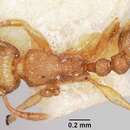en
names in breadcrumbs


Taxonomic history
Senior synonym of Tetramorium simillimum madecassum: Bolton, 1979 PDF: 156.Status as species: Bolton, 1979 PDF: 156.Tetramorium simillimum st. delagoense Forel , 1894: 80. Syntype workers, queens, males, Mozambique: Delagoa (Dr Liengme) (MHN, Geneva) [examined]. Tetramorium simillimum var. madecassum Forel , 1895«: 248. Holotype worker, Madagascar: Imerina (Sikora) (MNH, Geneva) [examined]. Syn. n.
Worker. TL 2.3 - 2.8, HL 0.56 - 0.66, HW 0.49 - 0.58, CI 84 - 89, SL 0.42 - 0.52, SI 84 - 92, PW 0.33 - 0.41, AL 0.61 - 0.80 (25 measured).
Mandibles finely sculptured with dense, weak striation or dense shagreening. Anterior clypeal margin entire. Frontal carinae strongly developed, extending back almost to the occiput and distinctly more strongly developed than the remaining cephalic sculpture. Antennal scrobes broad and quite shallow, but distinct. With the head in full-face view the sides immediately behind the eyes with a single short, stout hair projecting anteriorly. Alitrunk in profile usually with a slight indentation at the metanotal groove. Propodeal spines usually short and broadly triangular, sometimes reduced and blunted but never absent, the spines shorter than the metapleural lobes which are themselves broadly triangular in shape. Petiole node in profile somewhat variable in shape but usually the same as in simillimum (Fig. 38). In dorsal view the node broader than long. Dorsum of head longitudinally rugulose, the spaces between rugulae packed with a dense, conspicuous reticulate-punctate ground-sculpture or densely granular. Dorsal alitrunk finely rugulose, with distinct punctulation between the rugulae. Dorsal surfaces of petiole and postpetiole similarly but more faintly sculptured. All dorsal surfaces of head, alitrunk and gaster with scattered short, stout, blunt hairs. Colour yellowish brown to mid-brown.
This small species is a very close sibling of simillimum and was originally described as a variety of it. However, it differs consistently from simillimum by possessing a single projecting stout hair on the side of the head just below the eye, a feature absent from simillimum . Also, the scapes of delagoense tend to be relatively slightly longer, with SI 84 - 92, as opposed to SI 74 - 80 in simillimum .
Although known from Madagascar, delagoense does not appear to be very common there. It is an African species which has spread to Madagascar and it is common in eastern and southern Africa, being known from numerous collections from South Africa, Rhodesia, Angola, Tanzania, Kenya and Sudan.
Material examined
Madagascar: Bekonazy (nr Morondava) (W. L. Brown); Imerintsiatosika (nr. Tananarivo) (W. L. Brown).